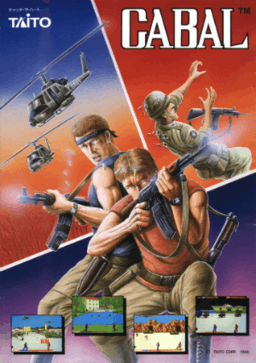Cabal (video game)
| Cabal | |
|---|---|
|
Japanese arcade flyer of Cabal. | |
| Developer(s) | TAD Corporation |
| Publisher(s) |
Taito Fabtek |
| Platform(s) | Arcade, Amiga, Amstrad CPC, C64, ZX Spectrum, DOS, NES |
| Release date(s) | 1988 |
| Genre(s) | Cabal shooter |
| Mode(s) | Single-player, 2 player Co-op |
Cabal (カベール Kabēru) is a 1988 arcade video game originally developed by TAD Corporation and published in Japan by Taito Corporation and in North America and Europe by Fabtek. In this game, the player controls a commando, viewed from behind, trying to destroy various enemy military bases.[1] The game was innovative for the era, and a modest success in sales.
Gameplay
.png)
Cabal offers one player and two-player-simultaneous modes of gameplay. Each player assumes the role of an unnamed commando trying to destroy several enemy military bases. There are 5 stages with 4 screens each. The player starts with a stock of three lives and uses a gun with limitless ammunition and a fixed number of grenades to fend off enemy troops and attack the base. The commando is seen from behind and initially starts behind a protective wall which can be damaged and shattered by enemy fire. To stay alive, the player needs to avoid enemy bullets by running left or right, hiding behind cover, or using a dodge-roll. An enemy gauge at the bottom of the screen depletes as foes are destroyed and certain structures (which collapse rather than shatter) are brought down. When the enemy gauge is emptied, the level is successfully completed, all of the remaining buildings onscreen collapse, and the player progresses to the next stage. If a player is killed, he is immediately revived at the cost of one life or game overs if he has no lives remaining. Boss fights, however, restart from the beginning if the only remaining player dies.
From time to time, power-ups are released from objects destroyed onscreen. Some power-ups give special weapons such as an extremely fast-firing machine gun or an automatic shotgun with a lower firing rate and larger area of effect. Others grant extra grenades or additional points.
The arcade cabinet is a standard upright. Each player uses a trackball to move their character from side to side and move the crosshairs about the screen. On later board revisions, a joystick was installed instead with an optional sub-pcb for use with a trackball. With a trackball, dodge-rolling is done by pushing the trackball to maximum speed.
Cabal was somewhat innovative in that it featured a 3D perspective in which the player character was situated in the foreground with an over-the-shoulder camera view, similar to modern third-person shooters. Although it is sometimes compared to contemporary games such as Commando and Ikari Warriors, it differs in that the player cannot move forward of his own volition; an area first needs to be cleared of enemies before the game automatically advances. Players cannot move the character while firing (holding down the fire button gives players control of the aiming cursor), and when moving the character to avoid incoming bullets, the aiming cursor moves along in tandem. This creates the need for a careful balance between offensive and defensive tactics, separating Cabal from run-and-gun shooters which relied more on reflexes. Advanced gameplay involves destructible asset management in balancing dodging (which gets riskier as the number of enemy projectiles on screen increases) with the safer alternative of taking cover behind a protective but limited durability wall. Overall it was somewhat popular and did respectably well in the arcades.
Ports and related releases

Cabal was ported to several home computers of the era, including the DOS computers, Amstrad CPC, Commodore 64, ZX Spectrum, Atari ST and Amiga. It was also ported to the Nintendo Entertainment System console by Rare. The quality of these ports varied based on the target system's capabilities.
Cabal was followed in 1990 by Blood Bros., though the sequel had a western theme as opposed to Cabal's Vietnam-era theme.
Reception
The game won the award for best advert of the year according to the readers of Crash magazine.[2] The game's success inspired many of its own "Cabal clones," such as NAM-1975 (1990) and Wild Guns (1994).[3]
See also
- Shootout, developed by TAD Corporation's related company Data East three years before Cabal.
- Dynamite Duke, featuring close combat in addition with similar shooting.
- Blood Bros., considered the "spiritual successor" of Cabal.
- Wild Guns, a SNES game featuring similar gameplay.
- Sin and Punishment, an N64 title featuring similar gameplay in different views, as well as close combat like Dynamite Duke.
- Zombie Panic in Wonderland, another similar game released on the Wii's WiiWare download service.
- NAM-1975, an NEO-GEO title with a similar gameplay.
References
- ↑ "Cabal". The International Arcade Museum. Retrieved 6 Oct 2013.
- ↑ http://www.crashonline.org.uk/75/awards.htm
- ↑ "Wild Guns". Hardcore Gaming 101. Retrieved 24 April 2012.
External links
- Rareware page
- Cabal at the Killer List of Videogames
- Cabal at MobyGames
- Cabal at World of Spectrum
- arcade history page
- Cabal compared to its 2002 spiritual successor, Gamshara
